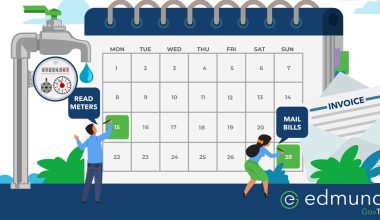Do you print your bills in-house using CASS Certification and POSTNET barcodes? If so, has the Postal Service contacted you with a deadline for making the change to Intelligent Mail barcodes? If not, they will be soon.
Even if you don’t print your own bills, have you heard of and wondered what Intelligent Mail barcodes are?
Continue reading to learn about Intelligent Mail barcodes and what will be involved in making the switch…
What is the difference between POSTNET and Intelligent Mail barcodes?
POSTNET and Intelligent Mail barcodes (IMb) are both barcodes that enable optical scanning equipment to read and sort mail at much faster rates than humans can. As you will see below, an Intelligent Mail barcode contains much more detail about the mailpiece than does a POSTNET barcode.
POSTNET explained
POSTNET is an acronym for POSTal Numeric Encoding Technique and has been in use since ZIP+4 was introduced in 1983. A POSTNET barcode includes the following data elements:
- ZIP code (5 digits)
- ZIP+4 (4 digits)
- Delivery Point Code, also known as DPC or DPBC (2 digits)
- Check digit (1 digit)
We all know what a ZIP code is; but the other elements of a POSTNET barcode are less well known.
Each ZIP+4 uniquely identifies the even and odd sides of the street for a block. For example, neighboring addresses 100 N Main St, 102 N Main St and 104 N Main St would all share the same ZIP+4. In most cases, for post office box addresses the ZIP+4 is the last four digits of the PO box number.
The DPC is the last two digits of the street address or PO box number. In the above example, the DPC for 100 N Main St is 00 and the DPC for 102 N Main St is 02. As you’ve probably figured out by now, the 11 digits represented by ZIP code, ZIP+4 and DPC represent a unique value for every address.
The check digit is a single digit that is used to verify the first 11 digits of the POSTNET using a sum of the digits modulo 10 algorithm. This is a fancy way of saying a value that when added to the sum of the first 11 digits yields a value that is evenly divisible by 10.
A POSTNET barcode consists of a series of half and full bars. All bars in a POSTNET barcode are ascenders, meaning that no bars drop below the base line. Each bar is a binary value (0 for half bars and 1 for full bars) and five bars comprise a digit. Here is an example of a POSTNET barcode:
![]()
Intelligent Mail barcodes explained
The Intelligent Mail barcode (IMb) is a 31 digit barcode that includes the following data elements:
- Barcode identifier (2 digits)
- Service type identifier (3 digits)
- Mailer ID (6 or 9 digits)
- Sequence number (9 or 6 digits)
- Delivery point ZIP code (11 digits)
The barcode identifier represents the level to which the mail piece has been sorted (i.e. carrier route, 5 digit ZIP, 3 digit ZIP prefix, etc).
The service type identifier is a value that identifies both the class of mail (first class, standard, priority mail, etc) and the services requested (address service requested, change service requested, etc).
The Mailer ID is a six or nine digit number assigned by the USPS that identifies the business sending the mail. High volume mailers will be assigned six digit Mailer IDs to allow a larger range of sequence numbers.
The sequence number is mailer assigned value that uniquely identifies each recipient. If claiming the full service discount, the sequence number must be unique for at least 45 days after the mailing, meaning the sequence number cannot be duplicated within 45 days.
The delivery point ZIP code is the same 11 digits that make up a POSTNET barcode.
Rather than the two symbols that make up a POSTNET barcode, IMb includes a central tracking region and both ascenders and descenders. This allows for four distinct symbols (tracking region only, ascending, descending and both ascending and descending). Here is an example of an Intelligent Mail barcode:
![]()
What is CASS Certification?
CASS is an acronym for Coding Accuracy Support System, the USPS’s process for insuring that all mail has a valid delivery address. CASS certification is a process that improves the accuracy of ZIP codes, ZIP+4 codes, delivery point codes and carrier routes. Mail that is presorted using CASS certification qualifies for postage discounts from the USPS. Essentially, the Postal Service is paying you to ease their workload with what they call “worksharing discounts”.
Processing a mailing that qualifies for the CASS certification discount involves several steps:
Insure your mailpiece (postcard bills or full page bills inserted in a window envelope) meet the requirements of the Postal Service
Process your mailing list with CASS certified software and generate a CASS report
Print your bills with POSTNET or IMb in the presorted sequence determined by the CASS certified software
Prepare your mailing in trays and grouped in packages as determined by the CASS software
Prepare a postage statement that includes the date of the most recent CASS report for your mailing
Deliver your mail and the postage statement to the USPS at the prescribed time and place
Obviously, the process of preparing a mailing to take advantage of these “worksharing discounts” involves a fair amount of work.
What is involved in making the change to IMb?
As we’ve seen, a utility bill mailed with IMb includes much more information than one mailed with POSTNET. This additional information provides the ability to track and trace individual pieces of mail.
To take advantage of the ability to trace mail using IMb, mailers must first complete an application and be approved by the Postal Service.
You must also purchase and pay the ongoing maintenance and support for CASS certified presorting software. If you are currently printing bills with POSTNET, you already have the CASS software. However, the difference is how often the list must be processed with the CASS software.
Currently, when printing bills with POSTNET, a CASS report is valid for up to six months. With IMb, each mailing must be processed with the CASS software because the results of the CASS presorting process are incorporated in the barcode identifier of the IMb.
Finally, you must have a printer that can print Intelligent Mail barcodes. This doesn’t sound like much, but most printers do not include the IMb font as a resident font, so an additional font package must be purchased. For Hewlett-Packard LaserJet printers, this requires the HP Barcode Printing Solution, available either as a font card or a USB device. Either of these options are only available for a limited number of printers as seen by clicking on the corresponding compatible products link. If you are currently printing bills using an HP LaserJet printer that is not on either of these compatible products lists, you will need to purchase a new printer in order to print IMb.
Is it time to switch to outsource bill printing?
If all this sounds like a lot of expense and work, that’s because it is! Outsource bill printing removes this responsibility, and the headaches that go along with it, from your office staff. The outsource printing vendor is responsible for meeting all of the requirements of the Postal Service and you still get the benefits of being able to track your mail using IMb.
If you are still printing bills in-house, now is a prime opportunity to consider outsourcing!


